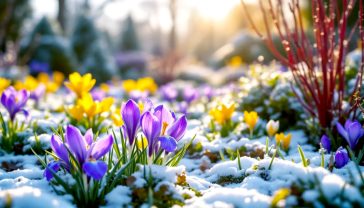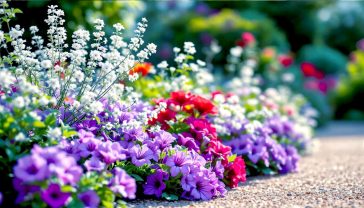From Hellebores to Hawthorns: 10 Great British Garden Plants Starting with H
Your definitive guide to 10 brilliant garden plants beginning with H. Explore popular choices like Hydrangea and Hosta, and native heroes like Hornbeam and Hazel.
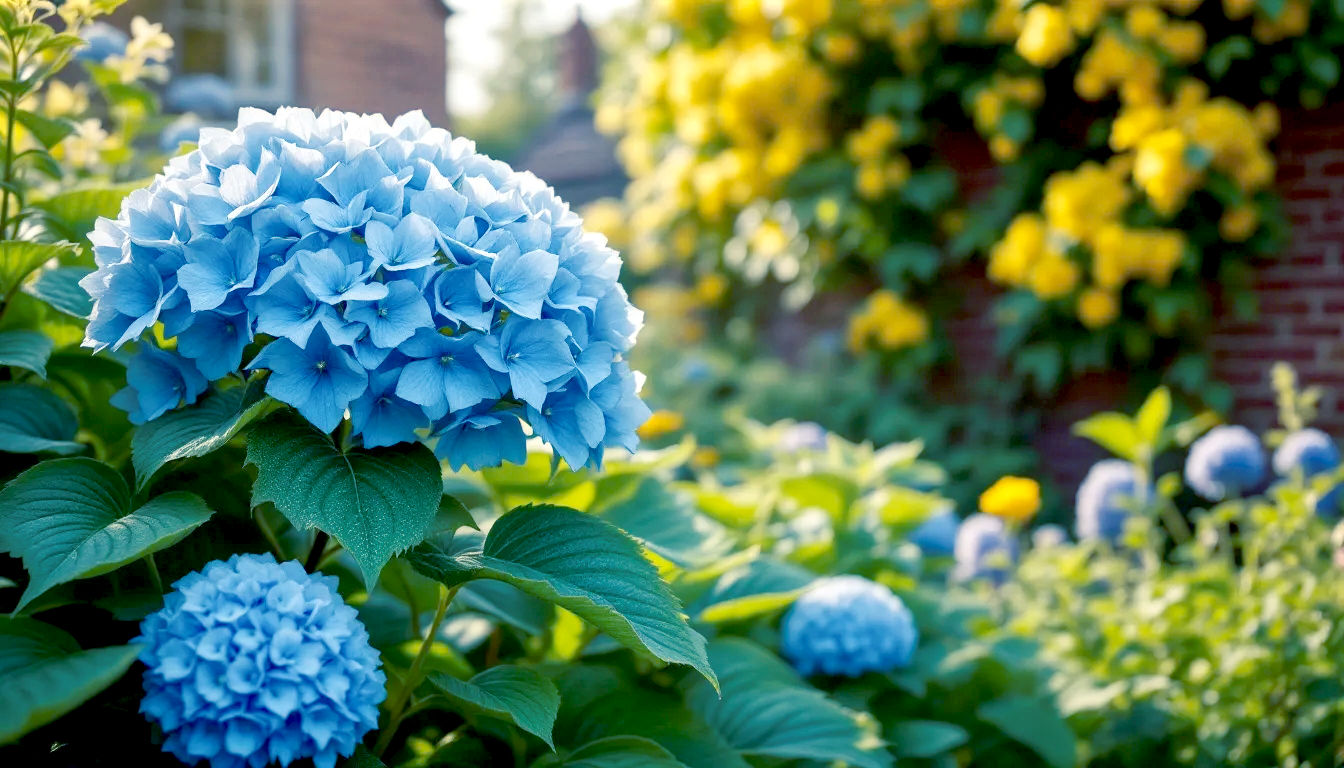
This post may contain affiliate links. If you make a purchase through these links, we may earn a commission at no additional cost to you.
Step into any British garden, and you’re stepping into a story. It’s a tale told in petals, leaves, and branches—a living library of colour, scent, and texture. And if you look closely, you’ll find that the chapter beginning with ‘H’ is packed with some of the most hardworking, handsome, and historic characters in the whole collection.
From the quiet courage of a Hellebore pushing through frozen soil to the ancient magic of a Hawthorn guarding a hedgerow, the ‘H’ plants are a wonderfully diverse bunch. They include grand shrubs that steal the show, tough little evergreens that provide year-round cheer, and native trees that have shaped our landscape and folklore for thousands of years.
Whether you have a sprawling country garden, a tidy suburban plot, or just a few pots on a balcony, there’s an ‘H’ plant for you. In this guide, we’ll introduce you to ten of the very best. We’ll explore what makes them special, how to grow them, and the fascinating stories they have to tell. So, grab a cuppa, get comfy, and let’s say hello to some horticultural heroes.
1. Hellebore (Helleborus): The Lenten Rose that Laughs at Winter
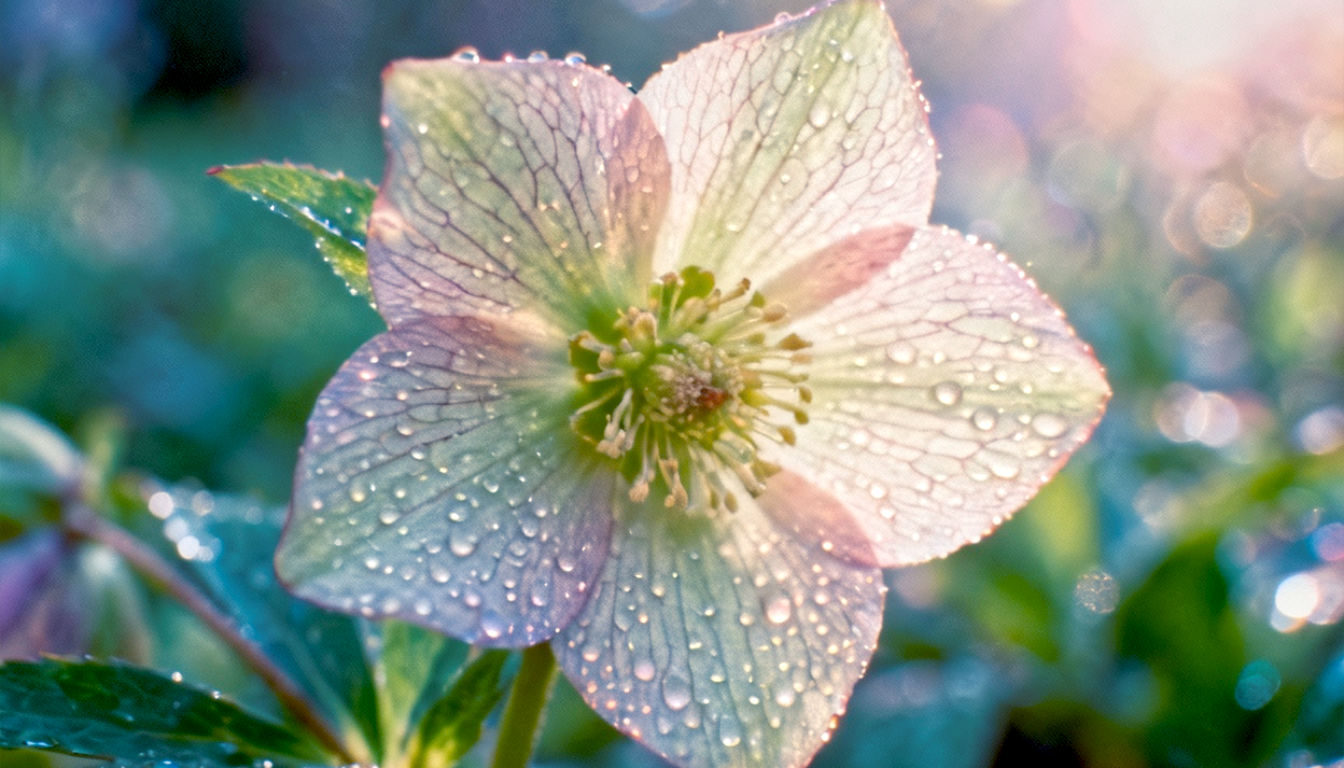
What is a Hellebore?
Just when the garden is at its greyest and most gloomy, the Hellebore opens its eyes. These incredible plants, often called the Christmas Rose or Lenten Rose, have the brilliant habit of flowering in the dead of winter and early spring. They’re not actually roses at all, but they bring a quiet elegance to the garden when almost nothing else is stirring. They are the perfect reminder that spring is just around the corner.
A Closer Look: Nodding Flowers and Tough Leaves
Hellebores have beautiful, bowl-shaped flowers that often nod downwards, as if shyly hiding from the winter chill. They come in a stunning range of colours—from pure white and soft pink to deep, velvety purple and speckled green. The ‘petals’ are actually sepals, which means they last for months, slowly fading to green but holding their shape.
Their leaves are just as handsome. They are tough, leathery, and deeply divided, looking a bit like a sturdy umbrella. Most are evergreen, providing welcome structure in the garden all year round.
Growing Hellebores in a British Garden
Hellebores are woodland plants at heart, so they’re happiest in a spot that mimics those conditions.
- Position: They love dappled shade, perhaps under a deciduous tree or on the shady side of a shrub. They don’t like baking summer sun or being battered by strong winds.
- Soil: They need rich, well-drained soil. If you have heavy clay, mix in plenty of compost or leaf mould to improve it. They really don’t like sitting in waterlogged ground.
- Care: Hellebores are wonderfully low-maintenance. Once they’re settled in, they’re very drought-tolerant. A good tip is to snip off the old, tatty leaves in late winter, just as the flower buds are emerging. This not only makes the plant look tidier but also shows off the flowers to their best advantage.
Top Hellebore Varieties for Your Garden
- Helleborus niger (Christmas Rose): The classic. Produces beautiful, pure white flowers from the depths of winter.
- Helleborus x hybridus ‘Harvington Double White Speckled’: A real show-stopper with frilly, double white flowers delicately freckled with maroon.
- Helleborus ‘Anna’s Red’: A modern star with stunning, deep reddish-purple flowers that face outwards, held above beautiful marbled leaves.
A Touch of Magic
Hellebores have a long and mysterious history. In ancient times, they were believed to have magical properties, capable of curing madness and warding off evil spirits. But handle with care—all parts of the plant are poisonous if eaten, a clever defence that stops deer and rabbits from munching on them.
2. Honeysuckle (Lonicera): The Scent of a Summer Evening
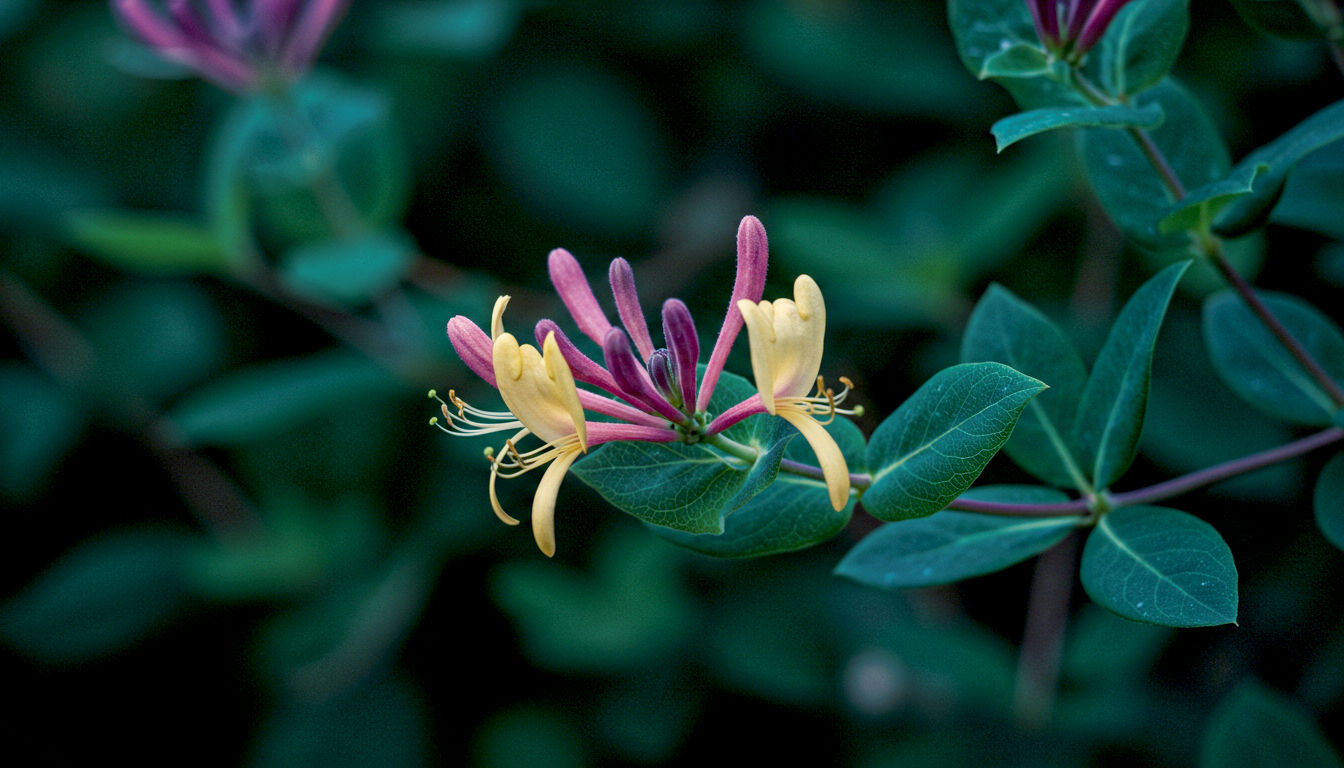
What is Honeysuckle?
Is there any scent more magical than Honeysuckle on a warm summer evening? This beautiful climber is the heart and soul of the British cottage garden. It scrambles happily over walls, fences, and arches, filling the air with its sweet, heady perfume. Our native Honeysuckle, Lonicera periclymenum, is a familiar sight in our woodlands and hedgerows.
A Closer Look: Twining Stems and Trumpet Flowers
Honeysuckles are twining climbers, which means their stems wrap themselves around any support they can find. They have simple, oval leaves that are often joined together at the base, forming a little cup.
But it’s the flowers we all love. They are intricate, trumpet-shaped blooms that appear in clusters from early summer to autumn. They are often a beautiful mix of colours—creamy white, sunshine yellow, and flushed pink—and look like tiny, exotic birds. After the flowers fade, they are followed by bunches of shiny, bright red berries.
Growing Honeysuckle in a British Garden
Honeysuckle has a simple rule for happiness: “sun on its head, cool at its feet.”
- Position: Plant the main stem in a shady, cool spot, but let the vine grow up into the sun. A good trick is to place a large stone or paving slab over the root area to keep it moist and cool.
- Soil: They are happy in most soils, as long as it’s not too dry or waterlogged. Adding some compost when planting will give it a great start.
- Care: Honeysuckle needs a sturdy support to climb up, like a trellis or wires. Pruning is simple: just give it a tidy-up after flowering to remove any tangled stems and encourage fresh growth.
Top Honeysuckle Varieties for Scent and Colour
- Lonicera periclymenum ‘Graham Thomas’: A classic and very popular variety with big, powerfully scented, creamy white flowers that age to yellow. A real powerhouse of perfume.
- Lonicera periclymenum ‘Serotina’: Known as the late Dutch honeysuckle, this one has gorgeous deep red-purple buds that open to creamy flowers. It flowers later in the summer.
- Lonicera japonica ‘Halliana’: A very vigorous, semi-evergreen variety with masses of pure white flowers that turn yellow. It’s great for covering a large area quickly.
A Wildlife Haven
Honeysuckle is a five-star hotel for garden wildlife. Its sweet nectar provides a vital food source for bees and hoverflies during the day. But at night, its perfume becomes even stronger to attract its main pollinators: long-tongued moths, like the beautiful elephant hawk-moth. In autumn, birds like thrushes and blackbirds feast on the berries, and the tangled stems provide safe nesting spots for wrens and dunnocks.
3. Hebe: The Tidy Evergreen from Down Under
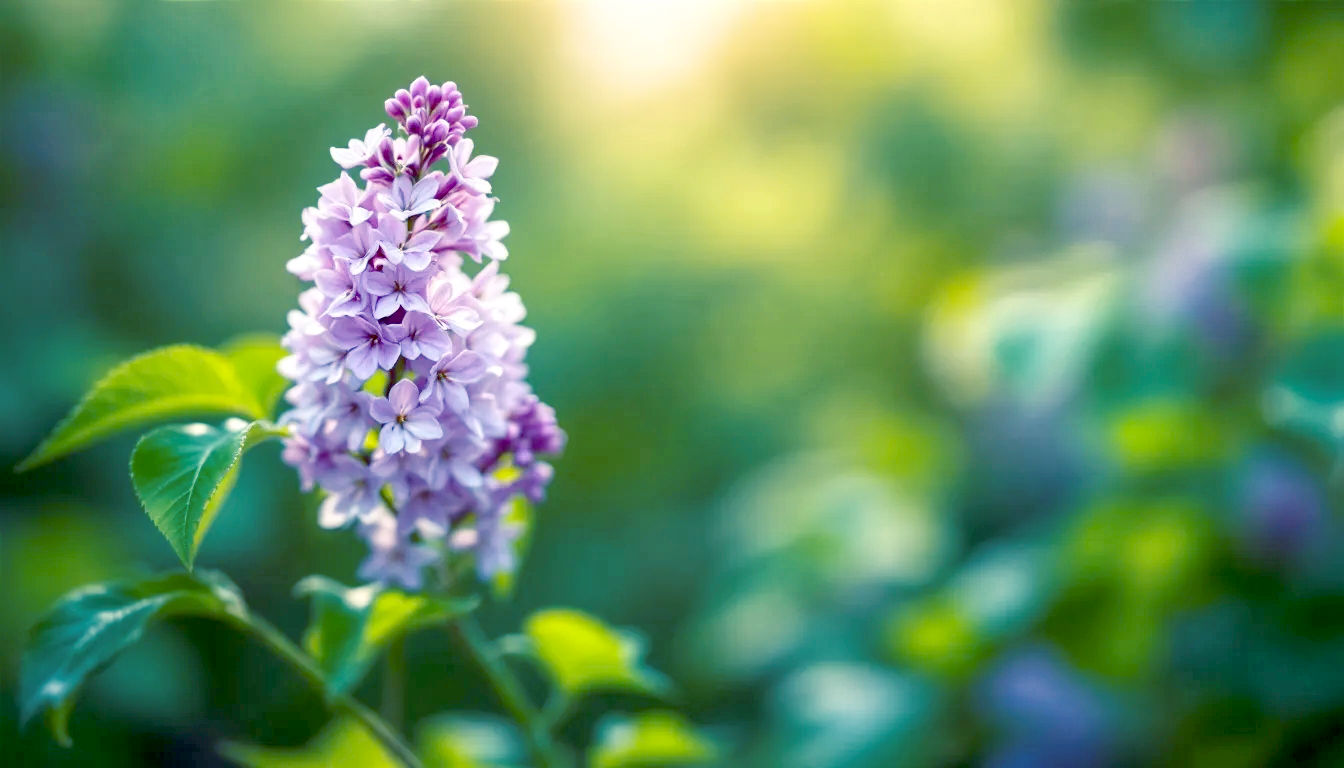
What is a Hebe?
If you want a reliable, good-looking, and fuss-free shrub, you can’t go wrong with a Hebe. These fantastic evergreens come all the way from New Zealand, but they have made themselves right at home in British gardens. They come in all shapes and sizes, from little round balls perfect for pots to large, handsome shrubs that form the backbone of a border.
A Closer Look: Smart Leaves and Poker-like Flowers
The beauty of a Hebe lies in its leaves. They are neatly arranged in pairs up the stem, creating a very smart, symmetrical look. They can be glossy green, silvery-blue, or even variegated with cream or pink. Some tiny-leaved varieties look almost like conifers.
From summer into autumn, most Hebes produce lovely spikes of flowers that look like little bottle brushes. These come in shades of white, pink, purple, and blue, and are a magnet for pollinators.
Growing Hebes in a British Garden
Hebes are generally easy to please, but they do have one main demand: good drainage.
- Position: They need a spot in full sun. They also appreciate a bit of shelter from cold, biting winds, especially in the north.
- Soil: Light, well-drained soil is essential. They hate having wet feet in winter, which can cause their roots to rot. If your soil is heavy, add grit when planting or grow them in pots.
- Care: Hebes are very low-maintenance. They rarely need feeding, and pruning is as simple as giving them a light trim after flowering to keep them looking neat and compact.
Top Hebe Varieties for Borders and Pots
- Hebe ‘Red Edge’: A superb small, rounded shrub with neat, blue-grey leaves that have a fine red margin, which deepens to purple in winter. It has pale lilac flowers in summer.
- Hebe ‘Great Orme’: A larger variety with long, glossy green leaves and wonderful spikes of bright pink flowers that fade to white.
- Hebe ‘Heartbreaker’: A modern, compact Hebe with striking cream-edged leaves that turn a vivid magenta-pink in winter. A fantastic plant for a pot.
A Pollinator’s Pal
When a Hebe is in flower, it’s a buzzing hub of activity. Bees and butterflies absolutely adore it. The flower spikes are made up of lots of tiny, individual flowers, each one packed with nectar. This provides a brilliant late-season food source, helping pollinators fatten up before winter.
4. Hydrangea: The Grand Dame of the Shrub Border
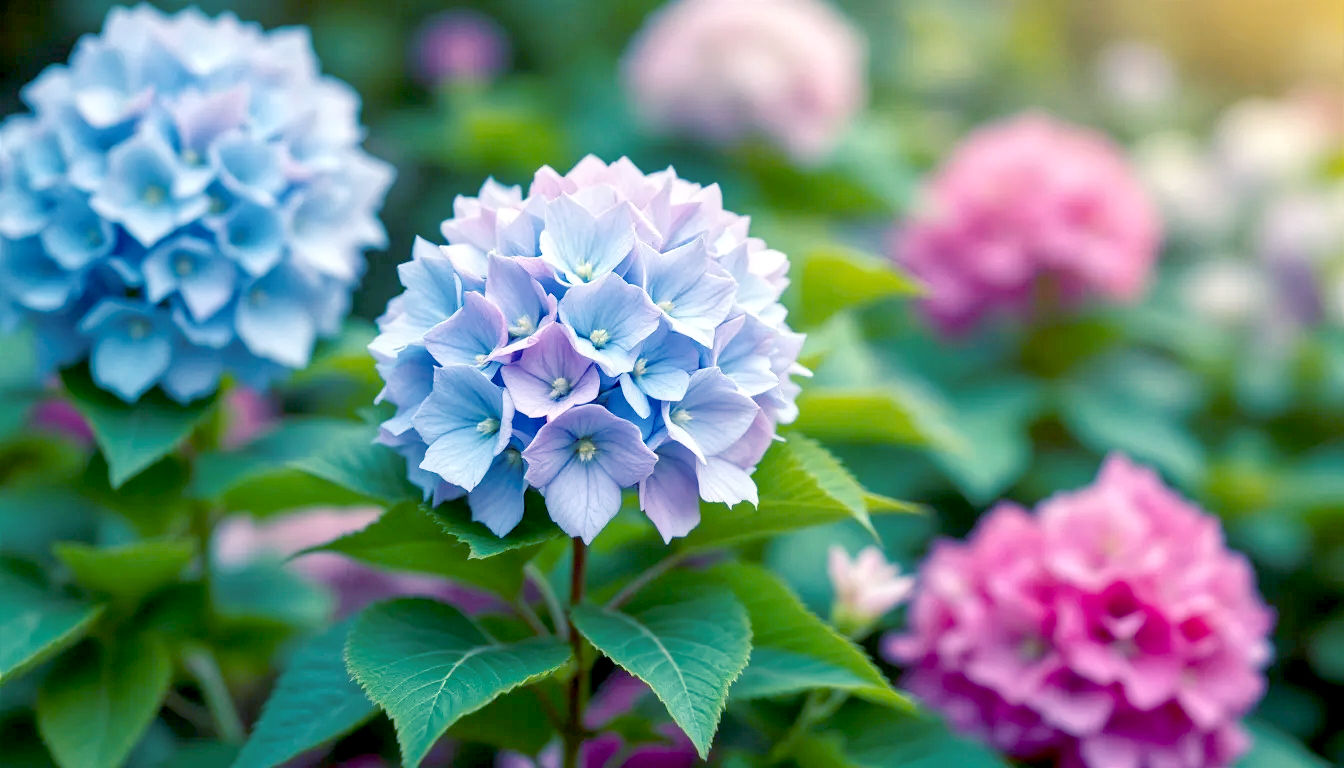
What is a Hydrangea?
With their huge, show-stopping flower heads, Hydrangeas are the undisputed queens of the summer garden. They have a slightly old-fashioned charm that brings to mind seaside towns and elegant country houses, but modern varieties have made them a must-have for gardens of every style. They are robust, reliable, and put on a spectacular show from mid-summer right through to autumn.
A Closer Look: Mopheads, Lacecaps, and Changing Colours
Hydrangeas are most famous for their massive flower heads. There are two main types you’ll see in British gardens:
- Mopheads (Hydrangea macrophylla): These have the classic, big, round flower heads that look like giant pom-poms.
- Lacecaps (Hydrangea macrophylla): These have flatter flower heads with a ring of large, showy petals around a centre of tiny, fertile flowers. They have a more delicate, graceful look.
The flowers themselves are fascinating. They last for months, changing colour as they age, often taking on beautiful, muted tones of green, pink, and deep red in the autumn. It’s worth leaving the dead flower heads on over winter, as they look wonderful when touched by frost and also protect the new buds underneath.
Growing Hydrangeas in a British Garden
Hydrangeas are thirsty plants, and their name gives us a clue—’Hydra’ comes from the Greek word for water.
- Position: They are happy in sun or semi-shade, but they don’t like to bake in the hot afternoon sun, which can cause them to wilt.
- Soil: They need moist, but well-drained soil. They really appreciate a good, thick mulch of compost or bark chips in spring to help lock in moisture.
- Care: The main job is to make sure they don’t dry out in summer. Pruning is done in early spring—simply cut back the stems that have flowered to a pair of fat, healthy buds.
Top Hydrangea Varieties for Modern and Traditional Gardens
- Hydrangea macrophylla ‘Endless Summer’: A game-changing ‘mophead’ that flowers on both old and new wood, meaning you get flowers all summer long.
- Hydrangea arborescens ‘Annabelle’: Produces enormous, spectacular globes of creamy-white flowers. It’s incredibly reliable and tough.
- Hydrangea paniculata ‘Limelight’: A very fashionable variety with large, cone-shaped flower heads that start a zesty lime-green before turning cream and finally a dusky pink.
The Colour-Changing Trick
One of the most magical things about many ‘mophead’ and ‘lacecap’ Hydrangeas is that you can change their colour. It’s not magic, it’s chemistry!
- In acidic soil (with a low pH), the flowers will be blue.
- In alkaline soil (with a high pH), the flowers will be pink.
If you have pink flowers but want blue ones, you can buy special ‘hydrangea colourant’ (which contains aluminium sulphate) to add to the soil. It’s much harder to turn a blue one pink! White hydrangeas, however, will always stay white.
5. Hawthorn (Crataegus monogyna): The Ancient Guardian of the Hedgerow
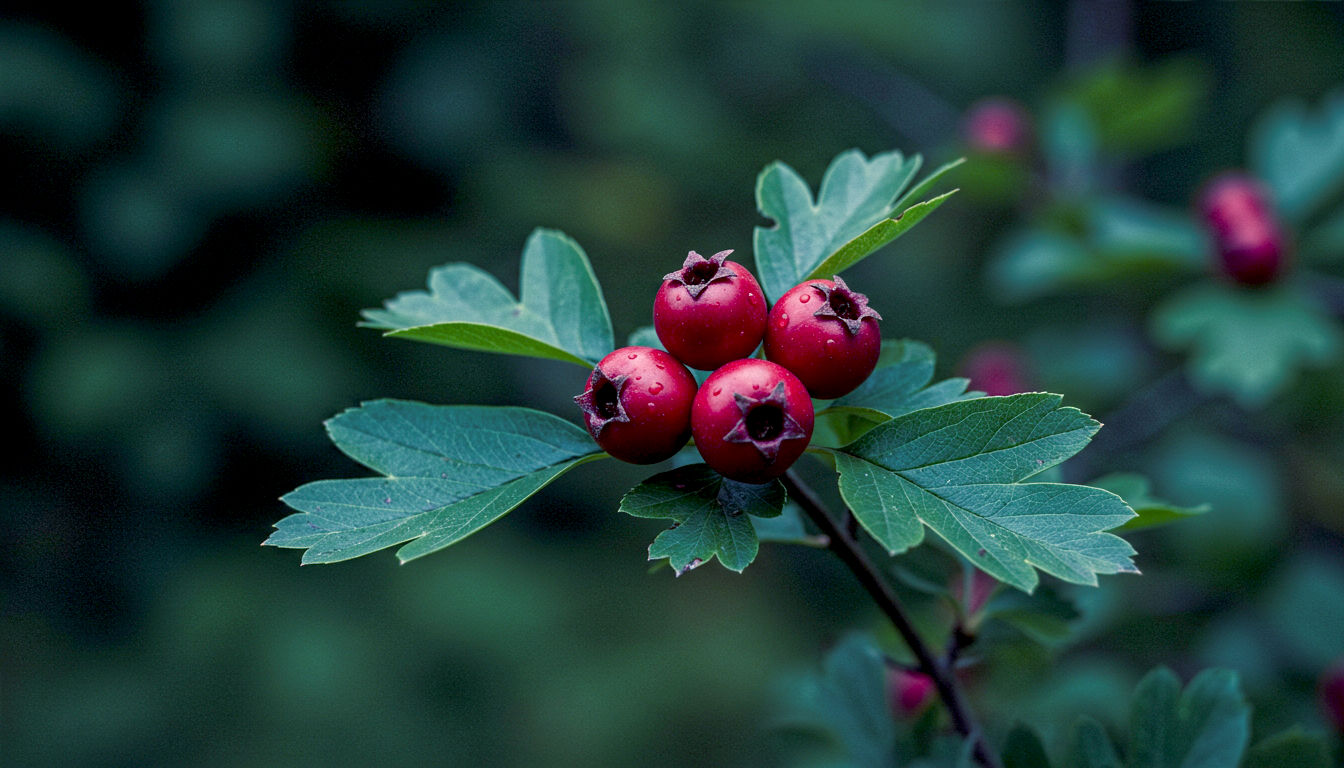
What is a Hawthorn?
The Hawthorn isn’t just a tree; it’s a living piece of our history. Also known as the May Tree, it’s a native British species that has been at the heart of our countryside for thousands of years. It’s the classic hedgerow tree, a tough, thorny character that stands as a guardian of fields and footpaths. It’s a tree of myth, magic, and immense value to wildlife.
A Closer Look: Thorny Branches, May Blossom, and Red Haws
Hawthorn is a small, dense, and thorny tree. Its bark is rugged and brown, and its branches twist into tangled shapes, providing a perfect fortress for small birds.
In late spring, usually around May, the tree covers itself in a blizzard of beautiful, fragrant, creamy-white blossom. The scent is sweet, earthy, and slightly almond-like. After the blossom, the tree produces deep green, lobed leaves. In autumn, these are followed by clusters of glossy, ruby-red berries called ‘haws’.
The Hawthorn’s Role in the UK
The Hawthorn is one of the most important trees for wildlife in the UK.
- Its dense, thorny branches provide safe nesting sites for over 150 species of bird, including dunnocks, blackbirds, and finches.
- The May blossom is a crucial source of nectar for bees, hoverflies, and other early insects.
- The leaves are the food plant for the caterpillars of many moths.
- In autumn, the red haws provide a vital winter feast for birds like redwings and fieldfares, as well as small mammals like dormice.
Growing Hawthorn in a British Garden
Hawthorn is incredibly tough and will grow almost anywhere.
- Position: It’s happy in full sun or partial shade.
- Soil: It will tolerate any soil type, from heavy clay to light sand. It can also cope with windy and exposed sites.
- Care: It needs no care at all once established. It can be grown as a single tree or, more commonly, as part of a hedge. Regular clipping will keep a Hawthorn hedge thick and impenetrable.
Steeped in Story
No other British tree is surrounded by so much folklore. Hawthorn was seen as a magical tree, a gateway to the fairy world. It was considered desperately unlucky to bring its blossom into the house. It’s also the tree from which the famous Glastonbury Thorn is said to have sprung. The name of the ship that carried the Pilgrims to America, the Mayflower, is a direct reference to the Hawthorn’s blossom, a symbol of hope and new beginnings.
6. Holly (Ilex aquifolium): The Evergreen King of Winter
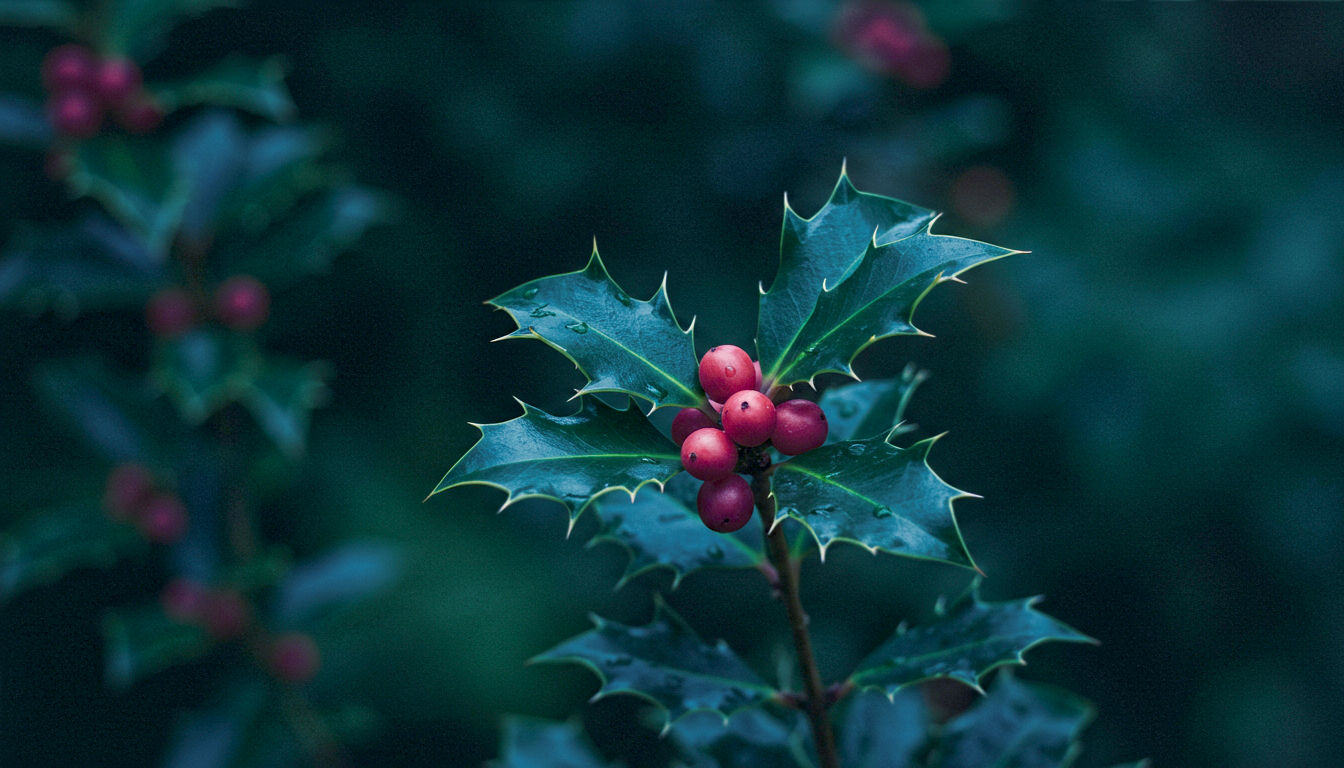
What is Holly?
Sharp, smart, and shining, Holly is the undisputed king of the winter garden. This handsome native evergreen is instantly recognisable, its glossy, spiky leaves and bright red berries a symbol of winter and, of course, Christmas. A sprig of Holly is a promise of life and colour in the darkest months of the year.
A Closer Look: Prickly Leaves and Ruby-Red Berries
Our native Holly, Ilex aquifolium, is a tree of two halves. The leaves on the lower branches are famously prickly, a brilliant defence against browsing animals like deer. Higher up the tree, where animals can’t reach, the leaves are often smooth and spineless.
The small, white flowers that appear in spring are quite modest, but they are followed by the main event: clusters of berries that ripen to a brilliant, jewel-like red in late autumn. These berries are a lifeline for birds in the harsh winter months.
Growing Holly in a British Garden
Holly is a slow-growing but very long-lived tree that is easy to look after.
- Position: It will grow happily in sun or shade.
- Soil: It’s not fussy about soil, but it does best in moist, well-drained ground.
- The Berry Secret: To get berries, you usually need both a male and a female plant. The female produces the berries, but only if a male plant is growing nearby to pollinate the flowers. Some modern varieties, like ‘J.C. van Tol’, are ‘self-fertile’, meaning you only need one plant to get berries.
Top Holly Varieties for Berries and Variegated Leaves
- Ilex aquifolium ‘J.C. van Tol’: A great choice because it’s self-fertile and has almost spineless leaves, making it easier to handle. It produces lots of berries.
- Ilex aquifolium ‘Argentea Marginata’: A classic ‘silver’ holly. This female variety has beautiful green leaves with a bold, creamy-white edge and produces bright red berries. You’ll need a male holly nearby for pollination.
- Ilex x altaclerensis ‘Golden King’: Don’t be fooled by the name—this is a female variety! It has lovely, almost spineless leaves with a bright golden-yellow margin.
A Symbol Through the Ages
Long before Christmas, Holly was a powerful pagan symbol. The Druids saw it as a sacred plant, its evergreen leaves representing everlasting life in the depths of winter. They would bring it indoors to provide shelter for woodland spirits. Later, this tradition was adopted by Christians, with the prickly leaves said to represent Christ’s crown of thorns and the red berries his drops of blood, making Holly a central part of Christmas decorations.
7. Hosta: The Lush Emperor of the Shade
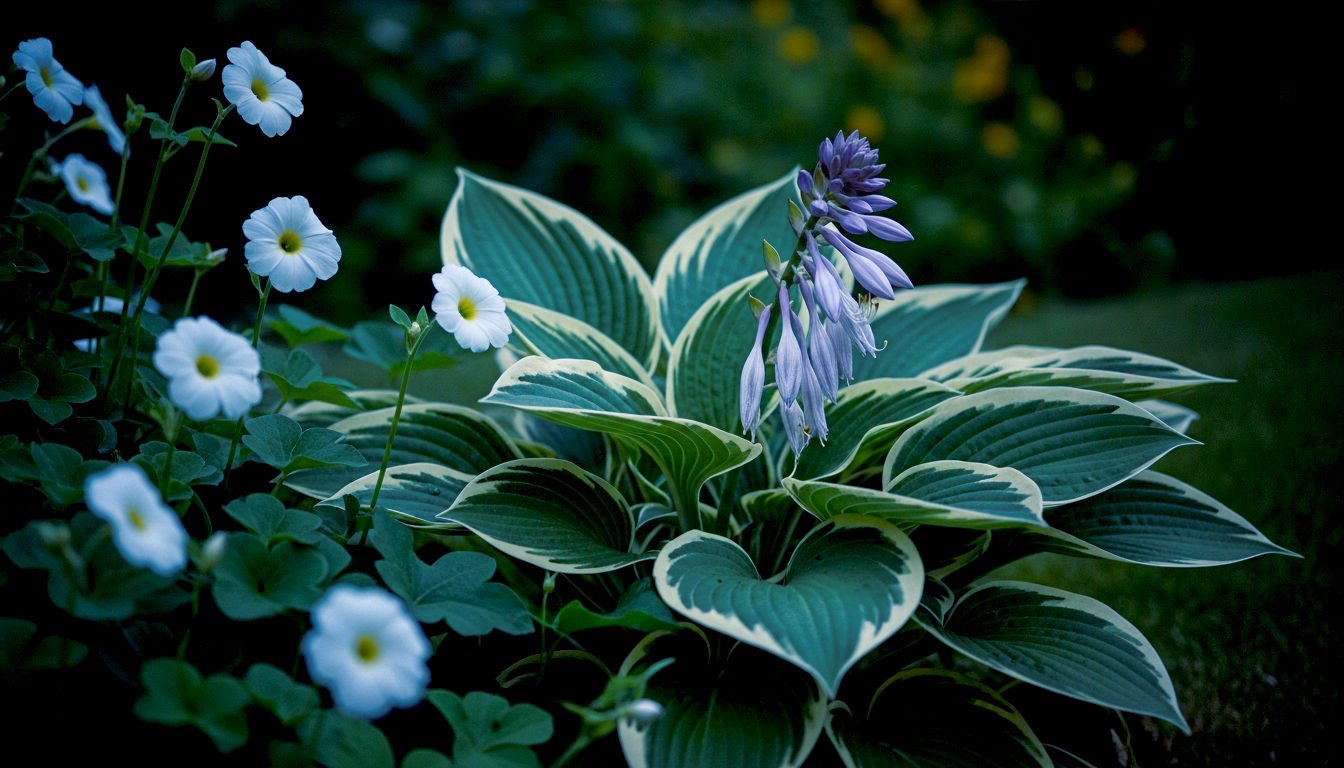
What is a Hosta?
Every garden has one—that tricky, shady spot where nothing seems to grow. Enter the Hosta. These magnificent foliage plants are the masters of shade, transforming dark, damp corners into a lush, tropical-looking paradise. They are grown not for their flowers, but for their incredible leaves, which come in an amazing variety of shapes, sizes, colours, and textures.
A Closer Look: A Masterclass in Foliage
Hostas are all about the leaves. They can be absolutely huge, like giant green dinner plates, or tiny and delicate. They can be heart-shaped, spear-shaped, or almost round. And the colours! There are Hostas in every shade of green imaginable, from bright lime to deep, dark olive. Many are variegated, with beautiful patterns in cream, white, or yellow. Some have a lovely blue-grey waxy coating, while others are puckered, ribbed, or crinkled. They are true architectural plants.
Growing Hostas in a British Garden
Hostas are easy to grow, as long as you remember one thing: slugs and snails think they are a Michelin-starred restaurant.
- Position: They are the ultimate plants for shade or semi-shade. A few varieties with thicker, yellower leaves can tolerate a bit of sun, but most will scorch.
- Soil: They need rich, moist soil to look their best. Dig in plenty of compost before planting.
- The Slug and Snail Battleground: This is the main challenge. Growing them in pots can help, as you can stand the pot in a saucer of water or put copper tape around the rim. On the ground, environmentally friendly slug pellets, beer traps, or just going out at night with a torch are the best lines of defence. Thicker-leaved, blue varieties (like ‘Halcyon’) tend to be a bit more resistant.
Top Hosta Varieties for Every Style
- Hosta ‘Frances Williams’: A true classic. It has huge, puckered, blue-green leaves with a wide, irregular creamy-yellow margin.
- Hosta ‘Halcyon’: Widely regarded as one of the best blue Hostas. It forms a neat mound of intense, spear-shaped, blue-grey leaves. It’s also quite slug-resistant.
- Hosta ‘Sum and Substance’: An absolute giant! It forms a massive clump of enormous, heart-shaped, chartreuse-green leaves that can handle a bit more sun.
More Than Just Leaves
Although we grow them for their foliage, Hostas do produce attractive spikes of flowers in summer. These are usually bell-shaped, in shades of lilac or white, and are held high above the leaves on elegant stems. They add a delicate touch and are loved by bees.
8. Hazel (Corylus avellana): The Wise Tree of Nuts and Knowledge
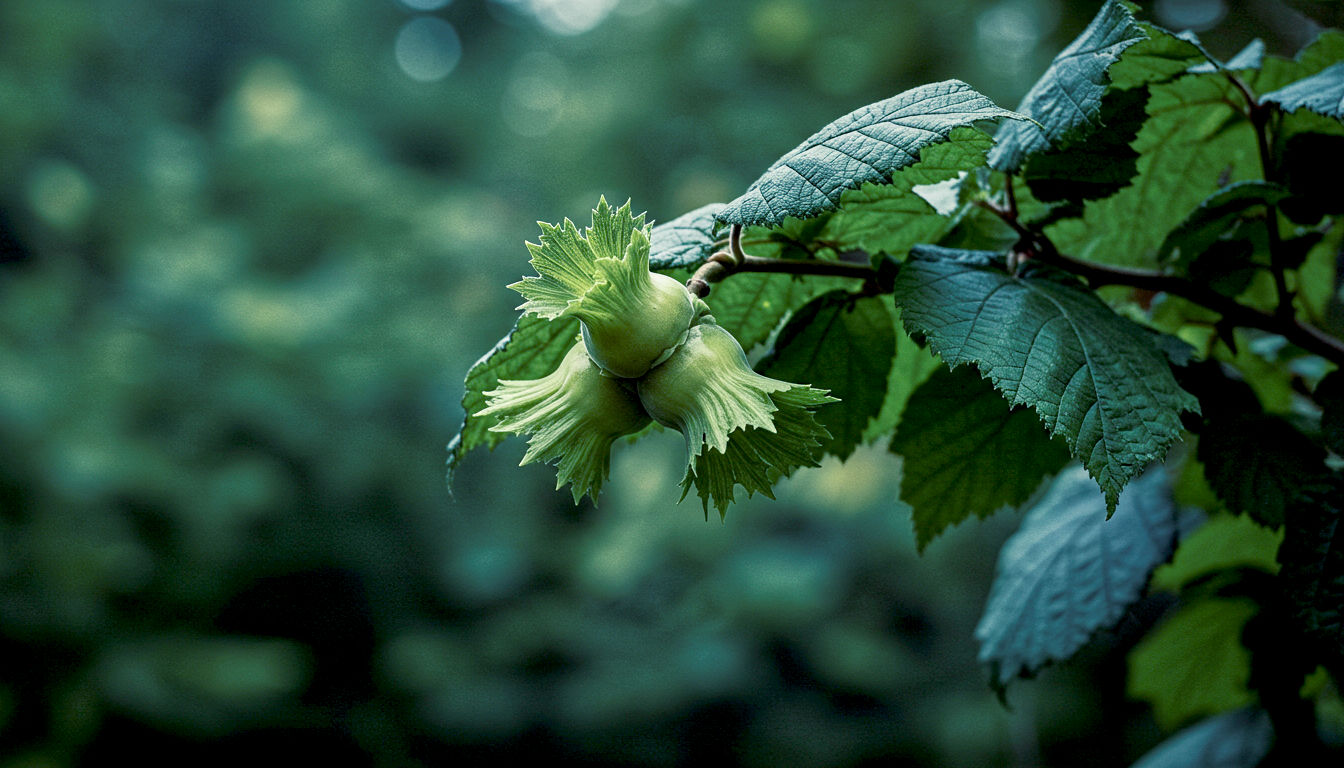
What is a Hazel?
Like the Hawthorn, Hazel is a true British native, a plant that has been intertwined with our lives for centuries. It’s a large shrub or small tree found in woodlands and hedgerows across the country. It’s famous for its beautiful spring catkins, its delicious nuts, and its bendy, useful wood. It’s a plant of wisdom, poetry, and perfect for a wildlife-friendly garden.
A Closer Look: Catkins, Nuts, and Bendy Branches
Hazel is one of the first trees to wake up after winter. In late winter, long before its leaves appear, the male flowers hang down in soft, yellow tassels called lamb’s tails or catkins. They dust the air with pollen on windy days. The female flowers are tiny, bud-like structures with a bright red tuft—you have to look very closely to spot them.
The leaves are soft, hairy, and almost heart-shaped. In autumn, the tree produces clusters of edible nuts, each one sitting in a frilly little cup. We know them as cobnuts or filberts.
Growing Hazel in a British Garden
Hazel is a very accommodating and useful plant for the garden.
- Position: It’s happy in sun or partial shade.
- Soil: It will grow in most soils but does best in ground that is moist but well-drained.
- Coppicing: Hazel responds brilliantly to a traditional woodland management technique called coppicing. This involves cutting the stems down to the ground every few years. The plant then sends up lots of new, straight, and flexible stems. This keeps the plant healthy and provides a regular supply of useful poles for the garden—perfect for beanpoles or plant supports.
Why Hazel Matters
Hazel is hugely important for our native wildlife. The nuts are a vital, high-energy food source for squirrels, woodpeckers, and small mammals like wood mice and the endangered hazel dormouse. The catkins provide early pollen for bees, and the leaves are eaten by the caterpillars of several moths.
Its bendy wood has been used for thousands of years to make everything from fences and furniture to water-divining rods. In folklore, Hazel was the tree of knowledge and wisdom. It was believed that eating its nuts would grant you insight and inspiration. Harry Potter’s first wand was, of course, made of Holly, but Hazel is another common wand wood, associated with intuition and protection.
A Taste of Autumn
If you’re lucky enough to have a Hazel tree, you can have a go at foraging for your own cobnuts in autumn. The trick is to get them before the squirrels do! Pick them when the husks start to turn yellowy-brown. You can eat them fresh (‘wet’) or dry them for storing over winter.
9. Heather (Calluna vulgaris): A Carpet of Colour on Windswept Moors
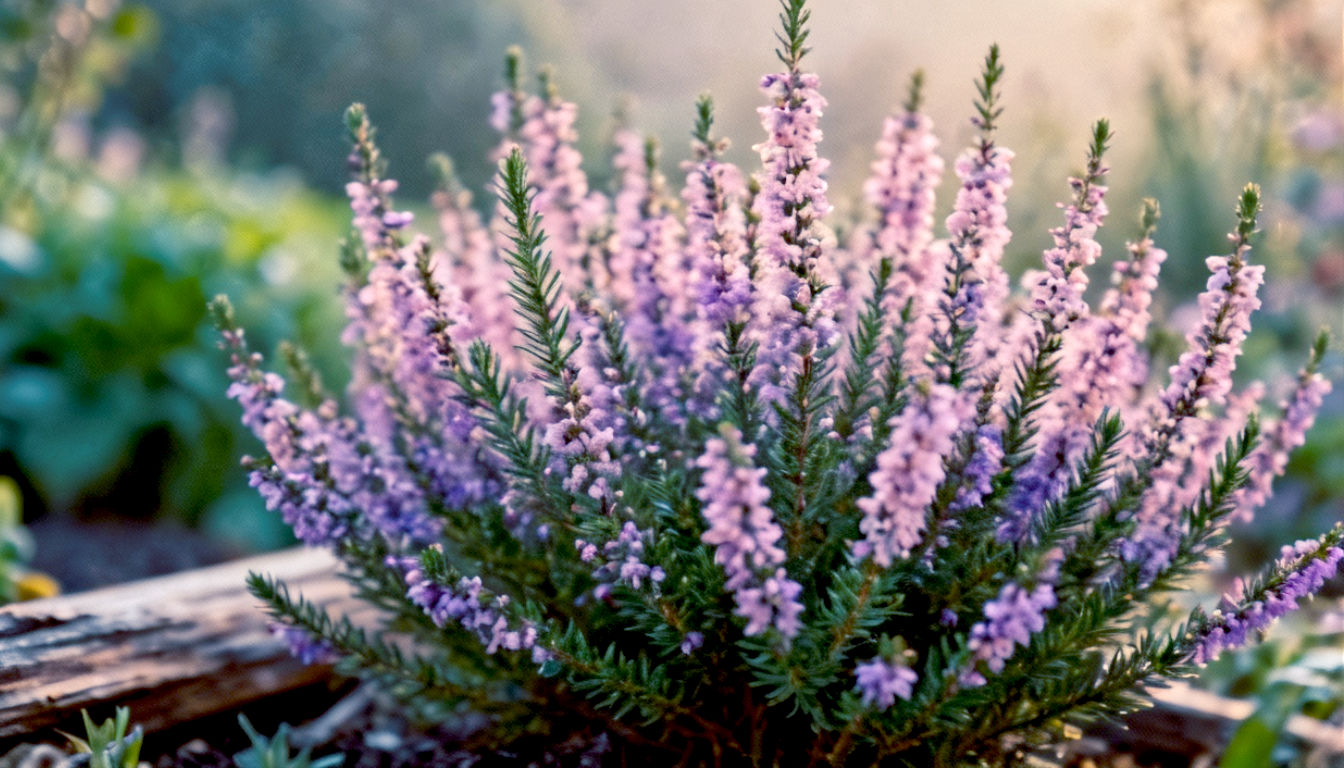
What is Heather?
Picture a wild Scottish moorland in late summer, and you’ll likely picture a vast, rolling carpet of purple Heather. This tough, low-growing shrub, also known as Ling, is an iconic part of the British landscape. But heathers aren’t just for windswept hillsides; with hundreds of varieties available, they can bring a splash of rugged beauty to any garden.
A Closer Look: Tiny Leaves and Spikes of Flowers
Heather is a small, wiry evergreen shrub. Its leaves are tiny and scale-like, packed tightly along the stems. This is a clever adaptation to reduce water loss in the windy, exposed places where it grows.
From mid-summer to late autumn, the plant is covered in spikes of tiny, bell-shaped flowers. In the wild, these are usually a mauve-purple colour, but garden varieties come in a huge range of pinks, purples, and whites. There are even heathers that flower in winter, bringing colour to the garden in the bleakest months.
Growing Heather in a British Garden
There is one golden rule for growing Heather successfully: they must have acidic soil.
- Position: They need an open, sunny spot.
- Soil: This is the crucial part. Heather is a calcifuge, which means it hates lime (alkaline soil). It needs acidic, peaty, or ericaceous soil to thrive. If your garden soil isn’t acidic, don’t worry—heathers are brilliant plants for growing in pots, where you can give them the ericaceous compost they love.
- Care: After flowering, give them a light trim with shears to snip off the dead flower heads. This will stop the plants from becoming woody and encourage a fresh flush of growth.
Top Heather Varieties for Year-Round Interest
- Calluna vulgaris ‘Spring Torch’: A summer-flowering heather with mauve flowers, but its real surprise is in spring, when the new foliage tips are a brilliant orange-red.
- Erica carnea ‘Myretoun Ruby’: This is a winter-flowering heather (Erica, not Calluna, but grown in the same way). It has fantastic, deep magenta flowers from winter to spring and dark green foliage.
- Calluna vulgaris ‘Silver Queen’: A lovely variety with soft lilac-pink flowers and beautiful, downy, silver-grey foliage all year round.
A Taste of the Moors
Heather is not just beautiful; it’s also incredibly useful. In the past, it was used for everything from thatching roofs to making brooms and bedding. Today, it’s most famous for producing heather honey. Bees that feed on heather flowers produce a unique, aromatic, and richly flavoured honey that is prized by food lovers all over the world. It’s a true taste of the British uplands.
10. Hornbeam (Carpinus betulus): The Refined Relative of the Beech
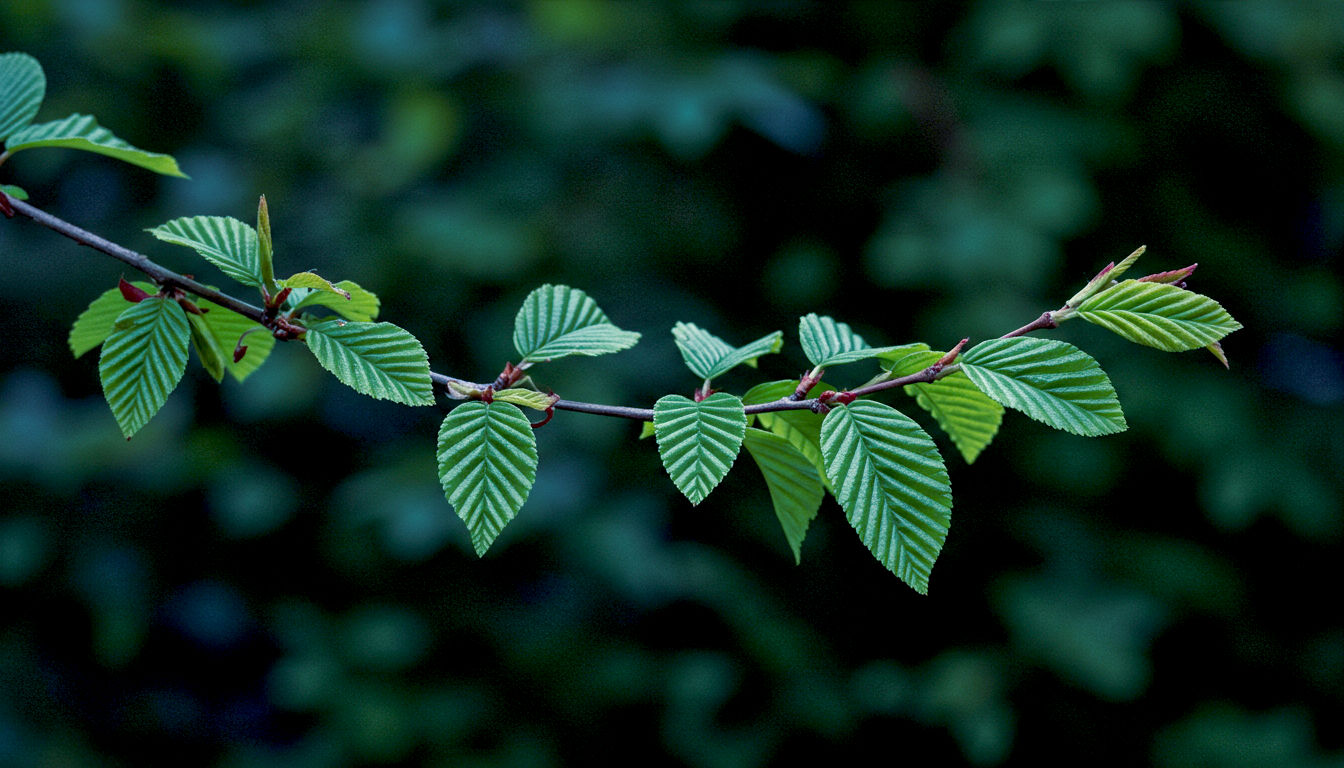
What is a Hornbeam?
Hornbeam is one of our finest native trees, yet it’s often overlooked in favour of its more famous lookalike, the Beech. Hornbeam is a handsome, hardy, and elegant tree that is particularly brilliant when used for hedging. It has a refined character, holding onto its coppery autumn leaves right through the winter, providing a wonderful screen and structure in the garden.
A Closer Look: Toothed Leaves and Papery Seeds
Hornbeam has beautiful, oval leaves that are a fresh, bright green. Unlike the smooth-edged leaves of Beech, Hornbeam leaves have finely toothed, serrated edges, a bit like a saw. In autumn, they turn a lovely golden-yellow before fading to a crisp, coppery brown.
Like Hazel, it produces catkins in spring. The seeds that follow in autumn are small nuts held in a distinctive, three-lobed papery wing, designed to be carried away by the wind.
Growing Hornbeam in a British Garden
Hornbeam is a tough, adaptable tree that makes it a superb choice for garden hedging.
- Position: It is happy in sun or shade.
- Soil: One of its great strengths is that it thrives on heavy clay soil, where Beech might struggle. It’s a great choice for tricky parts of the garden.
- Care: As a standalone tree, it needs no pruning. As a hedge, it should be clipped once a year in late summer to keep it neat and dense. One of its best features is that, like Beech, a clipped Hornbeam hedge will hold onto its dead leaves all winter, creating a year-round screen.
Hornbeam vs. Beech: How to Tell the Difference
People often confuse Hornbeam and Beech, especially when they are used for hedging. Here are the key differences:
| Feature | Hornbeam (Carpinus betulus) | Beech (Fagus sylvatica) |
|---|---|---|
| Leaves | Pointed tip, serrated edges | Wavy edges, with silky hairs |
| Bark | Grey, with a fluted, muscular look | Smooth, silver-grey |
| Buds | Small, green-brown, close to twig | Long, slender, sharp-pointed, copper |
| Soil | Happy on heavy clay | Prefers well-drained soil |
Hard as Horn
The name Hornbeam gives a clue to its main characteristic. The wood is incredibly hard and dense—the toughest of any native European tree. The ‘horn’ refers to its hardness, and ‘beam’ is an old word for tree. In the past, its exceptionally strong wood was used for things that needed to withstand a lot of wear and tear, like chopping blocks, tool handles, and even the moving parts of windmills.
Conclusion: A Garden Full of ‘H’eroes
And there we have it—ten horticultural heroes, each beginning with the letter ‘H’. From the delicate, nodding flowers of the Hellebore to the rugged strength of the Hornbeam, these plants offer something for every season and every style of British garden.
They remind us that a garden can be a source of year-round pleasure. It can be a fragrant haven for wildlife, a place of ancient stories, a source of delicious food, or simply a beautiful space to relax and reconnect with the rhythm of nature.
So next time you’re planning a new border or looking for a plant to fill a pot, we hope you’ll consider one of these handsome ‘H’s. You won’t be disappointed.
Further Reading
For more detailed information on growing these and other plants in the UK, these resources are invaluable:
- The Royal Horticultural Society (RHS): https://www.rhs.org.uk/
- The Woodland Trust: https://www.woodlandtrust.org.uk/
- BBC Gardeners’ World Magazine: https://www.gardenersworld.com/


